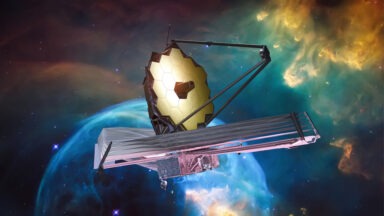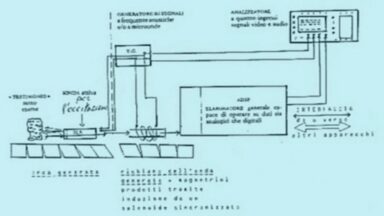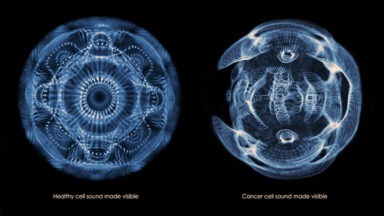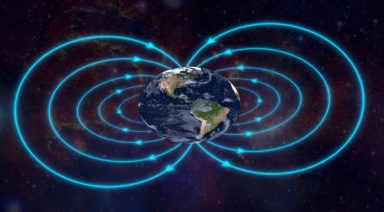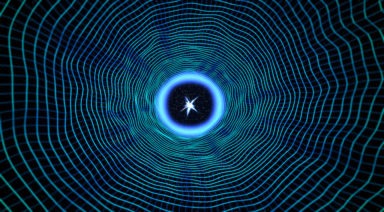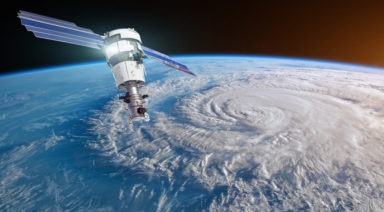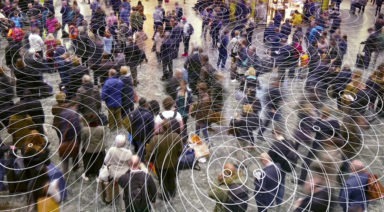Space Weather

As an entry point to the topic of space weather, let’s draw some comparisons between space weather and surface-based terrestrial weather.
There are at least two kinds of space weather that mankind has directly sampled with spacecraft. First is the environment that lies just outside the influence of planet Earth, meaning the conditions that reside beyond the influence and protection of earth’s magnetic field. This region is completely dominated by the solar wind from our Sun which is composed of electromagnetic radiation (radio waves, infra-red, light, ultraviolet, X-rays) and a slew of electrically charged particles that ride the magnetic field current well out past the distant orbit of Pluto.
Once this solar wind weakens to the point where it is overcome by the interstellar medium, we have entered a new weather environment. This boundary, or in weather terms a “front”, was first crossed on August 25, 2012 by Voyager 1 as it traveled from the sphere of influence dominated by the Sun and into the interstellar medium which is the vast “neutral zone” that exists between the stars.
Complex Interplanetary Relationships
As the Space Age began during the late 1950’s, our understanding of interplanetary space was very basic, plus the magnetic and electrical forces in space were not considered relevant to our day-to-day weather here on the surface of the planet. Now, seventy plus years down the road, our developing understanding of the complexity of the relationship between the Sun and the Earth’s is growing. Scientists are just beginning to comprehend the importance of the Sun’s own weather (sunspots and the state or configuration of it’s internal magnetic field) and how it directly impacts the short and longer term climate conditions here on Earth.
As a meteorologist with operational knowledge of the working of terrestrial weather processes, I am always on the look out for new information that will complement what wisdom I have regarding why our planet’s weather and climate systems “are the way they are” and just how our evolving understanding of the Sun-Earth magnetic relationship can and does impact our daily weather conditions and by default the climate.
The importance of solar weather can be put in perspective by the vast sums of dollars that have been invested in spacecraft to observe the Sun from numerous vantage points along our orbit, to gather real-time samples of the solar wind, plus constant observations, from space, of just how Earth’s magnetic field is interacting with the solar wind.
This ever changing magnetic field is our force field keeping all life safe from the ravages of the radiation from the Sun.
Climate: Cyclical in Nature
There is an undeniable volume of data, that includes patents, program names, observations and whistle-blowers that a global effort have been begun and has succeeded in altering the day-to-day weather patterns globally. The results of this program are presented to the public as “Global Warming” but now has been rebranded to the more generic inclusive term “Climate Change”.
This is rather humorous to me because everything is always in a state of flux, so despite the desire to keep the climate system stable, it never will be, has been or can be stable and without change. It is cyclical in nature and will always be weather warming or cooling from it’s present state. The climate changes, always.
Can We Alter the Weather with Technology
The greater question is can we alter our weather and climate with current available technologies? I say that we can, have and are presently doing so. The next and even greater question becomes: Can we change the Sun’s weather so that it has a desirable impact on Earth’s climate? Or might this technological feat be a bridge too far?
The next leap we must take is that of accepting that the pinnacle of human technology is not known to the public at large. That there remains a bevy of State and National secrets that are generations ahead of acknowledged technological capabilities. Now another intellectual step must be taken: How far, in technological terms, have other civilizations progressed and might we see evidence of their presence in some of the solar surveillance gathered during the fifty years that we’ve had eyes on the Sun?
For some reason I’ve always had a keen interest in the sky be it for the weather, airplanes and the planets and stars that lie beyond. I’ve never recoiled at the thought of UFOs or ETs, these always seemed like logical extensions of the abundance of life here on Earth.
The accepted scientific and religious concept that sentient life was constrained to just this single planet seemed Medieval at best. Astronomers are now discovering planets accompany every star and that habitable planets must number in the trillions. So, life and sentient lifeforms must be exceedingly abundant in this one single dimension of the observable Universe. Where there is matter there is life with some relative, either great or minuscule, state of awareness.
So, now back to our exercise in “How far advanced might have these other civilizations become in their potential millions of years of development?” If we are presently capable of engineering an entire planet’s weather/climate systems, could another far more advanced civilization engineer, to some degree, tweak the magnetic fields hence the weather of a star using massive structures?
Previously, I would have thought that this was an utterly ridiculous potential but then, twenty years ago, I would have said the same about chemtrails, scalar weaponry and etheric weather engineering. But as I became aware of the vast effort deployed to use Earth’s weather as a force multiplier the same might now be said of our Sun.
During the peak of solar cycle 23 that occurred in 2003 I became intensely aware of the relationship of, or the weather between, our Sun and the Earth. I experienced many amazing displays of aurora to far southern latitudes which became normal from the years 2000 to 2004. One of NASA’s satellites, The Solar and Heliospheric Observatory (SOHO), became a daily go-to for me as I watched these solar storms develop, erupt and then interact with earth’s protective magnetic field.
Anomalous Objects in SOHO Imagery
While becoming familiar with the imagery provided by SOHO I frequently saw “anomalous objects” that NASA described as being “…cosmic rays impacting the imaging sensor.”
The photographer, scientist, curious investigator and observer in me strongly disagreed with this simple assessment of these SOHO anomalies.
These features seemed far too complex, too structured, too unique to be simple cosmic rays. If these anomalous artifacts that appeared across all frequencies on these SOHO images were cosmic rays then why did they smear in a given five to 19 second exposure revealing that the source was moving in space while the image shutter was open for just seconds of time? All cosmic rays would also appear to be nearly identical in image after image, this was also not the case, not even close.
By this time, 2003, I was examining all SOHO imagery across all frequencies and they provided a treasure trove of anomalous targets to analyze. Very quickly my conclusion became the “More I looked, the more I saw.” There were already blocks of missing data where copy-and-paste blocks had been used to cover up parts of the imagery. So censorship was already actively underway. Then, the more I saw, the more I understood that NASA tells us absolutely nothing about what is really happening out there in our own neighborhood.
Earth based humans are but bit players on this galactic stage that includes our own backyard!
As I examined these space base structures I could begin to categorize them into specific sizes and shape sets, their activities and orbital movements in relationship to the Sun. What immediately became apparent was their immense size. These craft are not just dozens of feet in diameter like our spacecraft, but hundreds if not tens of thousands of miles in size. The one inhibiting factor in determining their exact size is that these images are taken from an unknown distance from the SOHO spacecraft. Just how far away from the cameras aboard SOHO are they, became the question. Thus, being able to triangulate their location from other orbiting NASA solar observatories easily allows to their exact size and location to be accurately determined. NASA and NSA have always had this relevant information.
My tentative conclusions were that I was seeing fleets of thousands upon thousands of craft transiting though the solar system.
Some spacecraft, in fact fleets of them, appear to be keenly interested in holes in the solar corona. Others interested in the magnetic storms that create Coronal Mass Ejections (CMEs) which then create geomagnetic storms here on Earth. At other times massive antenna arrays are formed when many of these spacecraft join together to form specific shapes or configurations to accomplish a given task.
Considering the unbelievable size and complexity of these operations one must consider the option that these greater intelligences have the ability to manipulate the magnetic fields of the Sun thereby altering this Solar System’s weather which is largely comprised of the plasma and electrical fields which emanate from our Sun.
It’s not that NASA wasn’t aware of these many spacecraft and their purpose here, but that NASA would go to whatever lengths deemed necessary to keep this information secret. For example, just shortly after my I began to publish these “cosmic ray anomalies”, I received an email from a NASA public relations office attempting to correct me as to my conclusions while politely stating that these were just sensor errors and not to read too much into their presence.
It wasn’t but a few weeks afterwards that a Gaussian blur filter was applied to all SOHO imagery that was publicly available from the website that hosted this data. This Gaussian blur filter effectively blurred out the relevant detail that previously made this imagery so interesting to all those investigators who would mine the SOHO imagery for evidence of advanced civilizations that are present today all throughout our Solar System.
Will NASA's New Telescope Discover ET Life?
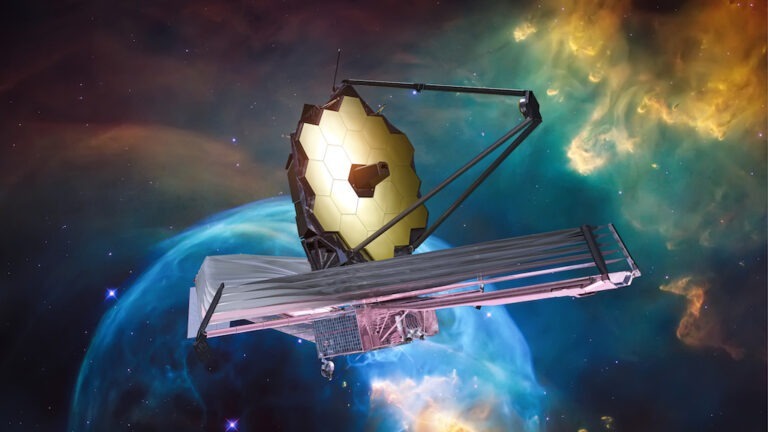
The spectacular first images from the James Webb Space Telescope are finally here and they do not disappoint.
After years of planning, construction, delays, and a cost of about $10 billion, we finally have the first images from the James Webb Space Telescope. Launched in December of 2021, the JWST is the largest and most powerful space telescope ever to be put in space.
Astronomers have waited a lifetime to see with such amazing clarity deep into space. JWST does this by operating in the infrared spectrum; it “sees” light that is outside the visible spectrum of our naked eye and previous telescopes like Hubble.
NASA released photos of the first five targets noting, “These first images from the world’s largest and most powerful space telescope demonstrate Webb at its full power, ready to begin its mission to unfold the infrared universe.”
We caught up with astronomer and Gaia News contributor Marc D’Antonio on the road in Arizona, to break down the images.
“I saw these images and the release of all five different images represent a different aspect of what this telescope can do — absolutely astonishing to me — from galaxies to gas clouds, this telescope hands down, has the ability to show us so much that we don’t understand.”



